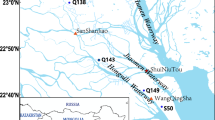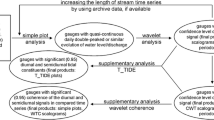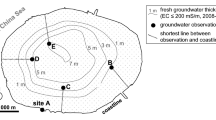Abstract
The efficacy and applicability of tidal response methods (TRMs) were assessed in terms of the techniques used, the, data used in the analysis, and the implementation of the methods under different conditions. The tidal efficiency (TE) and time lag (TL) methods were applied to directly measured groundwater head (GWH) values in the Motril-Salobreña coastal aquifer and compared with the same pre-filtered time series after eliminating the non-tidal signals through the continuous wavelet transform (CWT) procedure. The use of maximum and minimum groundwater peaks and sea-level peaks in combination to obtain different delay values and the effects of asymmetries in tidal fluctuations were assessed. Application of the TE method yields different D values when a complete groundwater head time series is considered, instead of the net induced tidal oscillation. Moreover, when the asymmetry of tidal oscillations is not taken into account, the application of TL may yield a higher uncertainty. In unconfined coastal aquifers, hydraulic diffusivity can be overestimated by the TE method if the non-tidal components are not removed from the measured time series of groundwater head. However, prior filtering provides better diffusivity results when the TE method is applied. The depth of the water head measurements leads to different D values when applying the TE method as a consequence of the changes in the specific storage with depth, which result from changes in pressure. The results of the application of the TL method depend on whether maximum or minimum peaks are used. Since the use of maximum peak delays can overestimate D, minimum peak delays are recommended, as they yield D values that are closer to the values obtained using the TE method.





Similar content being viewed by others
References
Ataie-Ashtiani B, Volker RE, Lockington DA (2001) Tidal effects on groundwater dynamics in unconfined aquifers. Hydrol Process 15:655–669. https://doi.org/10.1002/hyp.183
Banerjee P, Sarwade D, Singh VS (2007) Characterization of an island aquifer from tidal response. Environ Geol 55:901–906. https://doi.org/10.1007/s00254-007-1041-y
Bye J, Narayan KA (2009) Groundwater response to the tide in wetlands: Observations from the Gillman Marshes, South Australia. Estuar Coast Shelf Sci 84:219–226. https://doi.org/10.1016/j.ecss.2009.06.025
Calvache ML, Sánchez-Úbeda JP, Duque C, López-Chicano M, De la Torre B (2016) Evaluation of Analytical Methods to Study Aquifer Properties with Pumping Tests in Coastal Aquifers with Numerical Modelling (Motril-Salobreña Aquifer). Water Resour Manag 30:559–575. https://doi.org/10.1007/s11269-015-1177-6
Cartwright N, Nielsen P, Li L, Callaghan DP (2003a) Watertable waves in unconfined aquifers: sloping boundary effects. Coasts and Ports 2003, 16th Australasian Coastal and Ocean Engineering Conference
Cartwright N, Nielsen P, Dunn S (2003b) Water table waves in an unconfined aquifer: Experiments and modeling. Water Resour Res 39:1330. https://doi.org/10.1029/2003WR002185
Chapuis RP, Bélange C, Chenaf D (2006) Pumping test in a confined aquifer under tidal influence. Ground Water 44:300–305. https://doi.org/10.1111/j.1745-6584.2005.00139.x
Chattopadhyay P, Vedanti N, Singh VS (2015) A Conceptual numerical model to simulate aquifer parameters. Water Resour Manag 29:771–784. https://doi.org/10.1007/s11269-014-0841-6
Chen C, Jiao J (1999) Numerical simulation of pumping tests in multilayer wells with non-Darcian flow in the wellbore. Groundwater 37:465–474. https://doi.org/10.1111/j.1745-6584.1999.tb01126.x
Dronkers J (1986) Tidal asymmetry and estuarine morphology. Neth J Sea Res 20:117–131. https://doi.org/10.1016/0077-7579(86)90036-0
Duque C, Calvache M, Pedrera A, Martín-Rosales W, López-Chicano M (2008) Combined time domain electromagnetic soundings and gravimetry to determine marine intrusion in a detrital coastal aquifer (Southern Spain). J Hydrol 349:536–547. https://doi.org/10.1016/j.jhydrol.2007.11.031
Duque C, López-Chicano M, Calvache ML, Martin-Rosales W, Gómez- Fontalva JM, Crespo F (2011) Recharge sources and hydrogeological effects of irrigation and an influent river identified by stable isotopes in the Motril- Salobreña aquifer (Southern Spain). Hydrol Process 25:2261-2274. http: //onlinelibrary.wiley.com/doi/10.1002/hyp.7990/abstract
Erol S (2011) Time-frequency analyses of tide-gauge sensor data. Sensors 11:3939–3961. https://doi.org/10.3390/s110403939
Erskine A (1991) The effect of tidal fluctuation on a coastal aquifer in the UK. Ground Water 29:556–562. https://doi.org/10.1111/j.1745-6584.1991.tb00547.x
Ferris JG (1951) Cyclic fluctuations of water level as a basis for determining aquifer transmissibility. International Association of Scientific. Hydrology 33:148–155. https://doi.org/10.3133/70133368
Flinchem EP, Jay DA (2000) An introduction to wavelet transform tidal analysis methods. Estuar Coast Shelf Sci 51:177–200. https://doi.org/10.1006/ecss.2000.0586
Ibáñez S (2005) Comparación de la aplicación de distintos modelos matemáticos sobre acuíferos costeros detríticos. Ph.D. Thesis, University of Granada, 304 pp
Jacob CE (1950) Flow of groundwater. In: Rouse H (ed) Engineering hydraulics. Wiley, New York, pp 321–386
Jay DA, Flinchem EP (1995) Wavelet transform analyses of non-stationary tidal currents. Proceedings of the IEEE Fifth Working Conference on Current Measurement, 7-9 Feb 1995, St. Petersburg, FL, pp. 100–105. https://doi.org/10.1109/CCM.1995.516158
Jay DA, Flinchem EP (1997) Interaction of fluctuating river flow with a barotropic tide: a demonstration of wavelet tidal analysis methods. J Geophysi Res: Oceans 102:5705–5720. https://doi.org/10.1029/96JC00496
Jay DA, Flinchem EP (1999) A comparison of methods for analysis of tidal records containing multi-scale non-tidal background energy. Cont Shelf Res 19:1695–1732. https://doi.org/10.1016/S0278-4343(99)00036-9
Jha MK, Kamii Y, Chikamori K (2003) On the estimation of phreatic aquifer parameters by the tidal response technique. Water Resour Manag 17:69–88. https://doi.org/10.1023/A:1023018107685
Kacimov A, Abdalla O (2010) Water table response to a tidal agitation in a coastal aquifer: The Meyer-Polubarinova-Kochina theory revisited. J Hydrol 392:96–104. https://doi.org/10.1016/j.jhydrol.2010.07.040
Knudby C, Carrera J (2005) On the relationship between indicators of geostatistical, flow and transport connectivity. Adv Water Resour 28:405–421. https://doi.org/10.1016/j.advwatres.2004.09.001
Kong J, Song ZY, Xin P, Shen GJ (2011) A new analytical solution for tide-induced groundwater fluctuations in an unconfined aquifer with a sloping beach. China Ocean Eng 25:479–494. https://doi.org/10.1007/s13344-011-0039-0
Levanon E, Shalev E, Yechieli Y, Gvirtzman H (2016) Fluctuations of fresh-saline water interface and of water table induced by sea tides in unconfined aquifers. Adv Water Resour 96:34–42. https://doi.org/10.1016/j.advwatres.2016.06.013
Millham N, Howes B (1995) A comparison of methods to determine k in a shallow coastal aquifer. Ground Water 33:49–57. https://doi.org/10.1111/j.1745-6584.1995.tb00262.x
Nielsen P (1990) Tidal dynamics of the water table in beaches. Water Resour Res 26:2127–2134. https://doi.org/10.1029/WR026i009p02127
Parker BB (2007) Tidal analysis and prediction. NOAA Special Publication NOS CO-OPS 3. http://tidesandcurrents.noaa.gov/publications/Tidal_Analysis_and_Predictions.pdf
Sánchez-Úbeda JP, Calvache ML, Duque C, López-Chicano M (2016) Filtering methods in tidal-affected groundwater head measurements: application of harmonic analysis and continuous wavelet transform. Adv Water Resour 97:52–72. https://doi.org/10.1016/j.advwatres.2016.08.016
Slooten LJ, Carrera J, Castro E, Fernandez-Garcia D (2010) A sensitivity analysis of tide-induced head fluctuations in coastal aquifers. J Hydrol 393:370–380. https://doi.org/10.1016/j.jhydrol.2010.08.032
Trefry MG, Bekele E (2004) Structural characterization of an island aquifer via tidal methods. Water Resour Res 40:21. https://doi.org/10.1029/2003WR002003
Trefry M, Johnston C (1998) Pumping test analysis for a tidally forced aquifer. Ground Water 36:427–433. https://doi.org/10.1111/j.1745-6584.1998.tb02813.x
USES: Human Settlements on the Coast. (2017) United Nations, Atlas of the Oceans. http://www.oceansatlas.org/subtopic/en/c/114/
Zhou X (2008) Determination of aquifer parameters based on measurements of tidal effects on a coastal aquifer near Beihai, China. Hydrol Process 22:3176–3180. https://doi.org/10.1002/hyp.6906
Acknowledgements
This study was supported by project CGL2012-32892, which was funded by the Ministerio de Ciencia e Innovación; project CGL2016-77503-R, which was funded by the Ministerio de Economía y Competitividad; by research group RNM-369 of the Junta de Andalucía and by the Marie Curie International Outgoing Fellowship (624496). The tides dataset was supplied by State Harbours. Thanks go to Francisco Rueda Valdivia for his advice on Matlab® processing and to Christine Laurin for editing the article. The authors also wish to thank to the editor and two anonymous reviewers, who raised several comments that led to clear improvements in the final version of the manuscript.
Author information
Authors and Affiliations
Corresponding author
Rights and permissions
About this article
Cite this article
Sánchez-Úbeda, J.P., Calvache, M.L., López-Chicano, M. et al. The Effects of Non-TIDAL Components, Depth of Measurement and the Use of Peak Delays in the Application of Tidal Response Methods. Water Resour Manage 32, 481–495 (2018). https://doi.org/10.1007/s11269-017-1822-3
Received:
Accepted:
Published:
Issue Date:
DOI: https://doi.org/10.1007/s11269-017-1822-3




